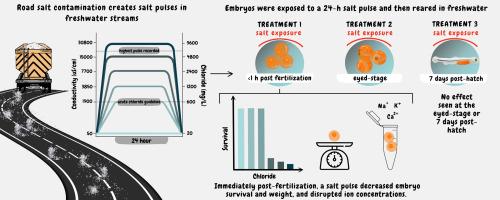脉冲暴露于道路盐对虹鳟鱼早期发育不同阶段的影响。
IF 4.3
3区 环境科学与生态学
Q2 BIOCHEMISTRY & MOLECULAR BIOLOGY
Comparative Biochemistry and Physiology C-toxicology & Pharmacology
Pub Date : 2025-08-27
DOI:10.1016/j.cbpc.2025.110334
引用次数: 0
摘要
鲑鱼在淡水溪流中产卵,包括受人类活动影响的城市地区的淡水溪流。在加拿大不列颠哥伦比亚省的温哥华地区,道路盐(主要是NaCl)的广泛使用与溪流中盐的频繁24小时“脉冲”有关,其中一些可能超过最高氯化物浓度的省级急性指南(600 mg L-1 Cl-)高达11倍。对于一些鲑科鱼类来说,道路上的盐腌正好是它们发育的关键阶段,因为许多物种在10月到1月之间产卵。研究了24小时盐脉冲(600-9600 mg L-1 Cl-)对虹鳟(Oncorhynchus mykiss)发育的浓度依赖性影响。在三个发育时间点之一施加盐脉冲:-1 Cl-,所有与环境相关的盐浓度。盐暴露结束时和眼期(盐暴露后17 天)全胚胎离子浓度的显著差异表明,盐对胚胎有持续的离子调节作用。在盐脉冲期间共同暴露于CaCO3,在离子贫乏的温哥华水中,溶解Ca2+的水平增加了2至3倍,大大降低了死亡率并改变了全身离子水平。这些发现支持了特定地点水质指南的必要性,因为毒性随水的离子组成而变化。这项研究还强调了改善道路盐化做法的必要性,以减少盐污染及其对鲑鱼发育的潜在不利影响。本文章由计算机程序翻译,如有差异,请以英文原文为准。

The effects of pulse exposures to road salt at various stages of early development in rainbow trout (Oncorhynchus mykiss)
Salmonids spawn in freshwater streams including those in urban areas that are impacted by human activities. In the Vancouver region of British Columbia, Canada, the extensive use of road salt (primarily NaCl) is associated with frequent 24-h “pulses” of salt in streams, some of which may exceed the provincial acute guideline for maximum chloride concentrations (600 mg L−1 Cl−) by up to 11-fold. For some salmonids, road salting coincides with critical developmental stages, as many species spawn between October and January. We explored the concentration-dependent effects of a 24-h salt pulse (600–9600 mg L−1 Cl−) on salmonid development using rainbow trout (Oncorhynchus mykiss). Salt pulses were imposed at one of three developmental time points: <1 h post-fertilization, the eyed-stage or 7 days post-hatch. Significant mortality occurred only in the <1 h post-fertilization treatment, at 2400, 4800 and 9600 mg L−1 Cl−, all environmentally relevant salt concentrations. Significant differences in whole-embryo ion concentrations at the end of the salt exposure and at the eyed-stage (17 days post-salt exposure) indicated lasting ionoregulatory effects on embryos. Co-exposure to CaCO3 during the salt pulse, at a level that increased dissolved Ca2+ by 2-to 3-fold in the ion poor Vancouver water, greatly reduced mortality and altered whole-embryo ion levels. These findings support the need for site-specific water quality guidelines, as toxicity varies with water's ionic composition. This research also highlights the need for improved road salting practices to reduce salt contamination and its potential adverse effects on developing salmonids.
求助全文
通过发布文献求助,成功后即可免费获取论文全文。
去求助
来源期刊
CiteScore
7.50
自引率
5.10%
发文量
206
审稿时长
30 days
期刊介绍:
Part C: Toxicology and Pharmacology. This journal is concerned with chemical and drug action at different levels of organization, biotransformation of xenobiotics, mechanisms of toxicity, including reactive oxygen species and carcinogenesis, endocrine disruptors, natural products chemistry, and signal transduction with a molecular approach to these fields.

 求助内容:
求助内容: 应助结果提醒方式:
应助结果提醒方式:


